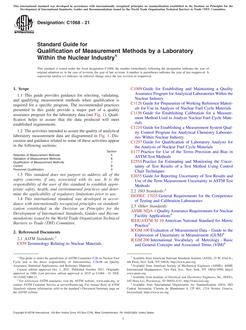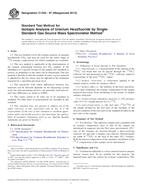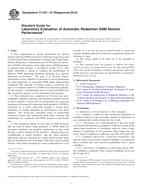1.1 This guide describes passive neutron measurement methods used to nondestructively estimate the amount of neutron-emitting special nuclear material compounds remaining as holdup in nuclear facilities. Holdup occurs in all facilities in which nuclear material is processed. Material may exist, for example, in process equipment, in exhaust ventilation systems, and in building walls and floors.
1.1.1 The most frequent uses of passive neutron holdup techniques are for the measurement of uranium or plutonium deposits in processing facilities.
1.2 This guide includes information useful for management, planning, selection of equipment, consideration of interferences, measurement program definition, and the utilization of resources.
1.3 Counting modes include both singles (totals) or gross counting and neutron coincidence techniques.
1.3.1 Neutron holdup measurements of uranium are typically performed on neutrons emitted during (α, n) reactions and spontaneous fission using singles (totals) or gross counting. While the method does not preclude measurement using coincidence or multiplicity counting for uranium, measurement efficiency is generally not sufficient to permit assays in reasonable counting times.
1.3.2 For measurement of plutonium in gloveboxes, installed measurement equipment may provide sufficient efficiency for performing counting using neutron coincidence techniques in reasonable counting times.
1.4 The measurement of nuclear material holdup in process equipment requires a scientific knowledge of radiation sources and detectors, radiation transport, modeling methods, calibration, facility operations, and uncertainty analysis. It is subject to the constraints of the facility, management, budget, and schedule, plus health and safety requirements, as well as the laws of physics. This guide does not purport to instruct the NDA practitioner on these principles.
1.5 The measurement process includes defining measurement uncertainties and is sensitive to the chemical composition, isotopic composition, distribution of the material, various backgrounds, and interferences. The work includes investigation of material distributions within a facility, which could include potentially large holdup surface areas. Nuclear material held up in pipes, ductwork, gloveboxes, and heavy equipment is usually distributed in a diffuse and irregular manner. It is difficult to define the measurement geometry, identify the form of the material, and measure it.
1.6 Units-The values stated in SI units are to be regarded as the standard. No other units of measurement are included in this standard.
1.7 This standard does not purport to address all of the safety concerns, if any, associated with its use. It is the responsibility of the user of this standard to establish appropriate safety, health, and environmental practices and determine the applicability of regulatory limitations prior to use.
1.8 This international standard was developed in accordance with internationally recognized principles on standardization established in the Decision on Principles for the Development of International Standards, Guides and Recommendations issued by the World Trade Organization Technical Barriers to Trade (TBT) Committee.









